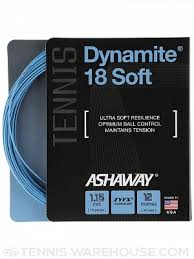Just what is soft string?
 Someone recently commented on “softer” polyester strings, and one response was “What is soft?”. Traditional polys are quite stiff, and at www.gssalliance.com, we test strings for power potential, which is a by-product of elongation, or how much a string stretches. All strings undergo the EXACT same testing process, so the procedure is consistent among all strings tested.
Someone recently commented on “softer” polyester strings, and one response was “What is soft?”. Traditional polys are quite stiff, and at www.gssalliance.com, we test strings for power potential, which is a by-product of elongation, or how much a string stretches. All strings undergo the EXACT same testing process, so the procedure is consistent among all strings tested.If a string is very stiff it’s obviously not going to stretch much at impact and therefore, the dynamic of energy absorption is negated. The more a string stretches at impact, the more energy it absorbs and thus, that energy is returned to the ball, increasing the power of the shot. Each string we test has a numeric designation based on a mathematical formula that’s applied when the string is stretched at 60 pounds and a measurement is taken. The higher the number, the more the string stretches and in turn, the more it could be classified as a “soft” or “softer” string.
So, for example, one of the strings mentioned in the recent post has an IART power potential rating of 7.18 while the other string it was being compared to had a power potential of 4.37. Why does this matter? For starters, we often hear people commenting on “softer” strings with no real distinction about how they arrived at their conclusion that string A is softer than string B. A manufacturer can promote a string as being “softer” BUT, softer than what? What if they were comparing it to a steel rod? That would certainly substantiate their claim of “softer” right? So, be careful and challenge that person to explain exactly what they mean when they say “softer”.
We currently have 357 different strings in our data base and you can search by “String Type”. Nylon (synthetic gut), Multifilament, Natural gut, Polyester, Kevlar & PEEK (Poly Ether Ether Keytone-think Ashaway MonoGut. To the surprise of many, Ashaway’s MonoGut ZX 16 has the highest power potential of any string we’ve tested coming in at 15.64. The lowest in our DB is Kirschbaum P2 with a rating of just 0.22. WOW!!! You can also search our DB by manufacturer name so if you want to take a quick peek at all of the Luxilon or Wilson strings and compare power potential you can do that very easily.
Keep in mind too that just because a string has a low power potential rating that doesn’t mean it’s a bad string. Touring pros use a lot of string with low power potential HOWEVER, they generate a ton more racquet head speed than the average player. If they used a string with a very high elongation rate you would have to string it extremely high before they would ever be able to control the ball. After that it can get complicated. For instance, the higher you start cranking the tension, the smaller the sweet spot becomes in many instances so there’s a lot to be taken into consideration when selecting a string & tension set-up for a specific player.
So, the next time someone tells you a string is “soft” this information should give you some guidelines on where to take your conversation. The IART website group is a group of worldwide racquet technicians who are highly trained and use our resources, like the String Characteristics DB, to give their clients the best advice available.

Comment (1)
Hi Tim,
Thank you for your well written article(s). I always look forward to them because they are interesting, easy to read, timely, and informative. They keep me abreast of the new stuff coming out and help me to remember the information I’ve already learned, especially as an MRT.
Bob J.